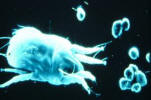Home
A Broad Introduction
Allergy Concepts
Food Issues
Asthma
Rhinitis & Hay Fever
Eczema
Children & Infants
Allergy to Animals
Finding Answers



|
 Lips touched with Brazil Nut Lips touched with Brazil Nut
 The most dangerous reaction which can occur to food is anaphylactic
shock after eating tiny amounts of a specific food. This happens
because the body has developed a specific IgE antibody against that
food which circulates in the blood and sensitises mast cells all
over the body. These sensitised ‘mast cells’ disintegrate on contact
with the food molecules, liberating histamine and other substances
which cause a generalised reaction such as a rash all over, a drop
in blood pressure, and collapse. The most dangerous reaction which can occur to food is anaphylactic
shock after eating tiny amounts of a specific food. This happens
because the body has developed a specific IgE antibody against that
food which circulates in the blood and sensitises mast cells all
over the body. These sensitised ‘mast cells’ disintegrate on contact
with the food molecules, liberating histamine and other substances
which cause a generalised reaction such as a rash all over, a drop
in blood pressure, and collapse.
After the victim has recovered it is vitally important that the
cause is pin-pointed by referral to an allergist as soon as
possible. Skin prick tests and blood tests may be positive but, if
the suspected cause is an unusual food, special testing material may
not be available for skin or blood tests. In this situation a test
may be improvised by using the suspected substance itself for a
prick test. The suspect food may have to be supplied by the patient.
When discovered the cause must be carefully avoided to prevent any
more attacks.. The most common causes are nuts, especially peanut,
lupin flour in pastry, latex rubber, celery, milk, and seafood., but
any food whatever can cause allergy on rare occasions. If the food
is vomited up immediately, or got rid of by acute diarrhoea, enough
to cause a severe reaction may not have been absorbed
In this country at present it is not uncommon for no cause to be
found, and a diagnosis of “Idiopathic Anaphylaxis” made. It should
always be explained clearly to the patient that this diagnosis means
that the cause has not been found, and therefore another attack
could occur at any time.
Why some foods are more liable to cause
anaphylaxis than others is unknown. Recent clinical and
immunological research has found that because of similarities in the
structure of the molecules of latex rubber to Kiwi, banana, melon,
mango, fig, and buckwheat, serious reactions may also occur in
rubber allergic patients after eating these foods. Reactions in the
mouth and lips to various fruits in people who are allergic to birch
tree pollen in April and May have been shown to be caused in the
same way by cross-sensitisation.

 Other Causes of Anaphylaxis Other Causes of Anaphylaxis
 Stings from wasps, bees, and other insects which inject their venom
can also cause anaphylaxis. This is one of the very few allergic
problems which are presently treated by the NHS using
desensitisation techniques, if an allergy centre can be found to
carry it out. This treatment consists of injections of gradually
increasing doses of venom until the patient becomes desensitised and
no longer reacts. Stings from wasps, bees, and other insects which inject their venom
can also cause anaphylaxis. This is one of the very few allergic
problems which are presently treated by the NHS using
desensitisation techniques, if an allergy centre can be found to
carry it out. This treatment consists of injections of gradually
increasing doses of venom until the patient becomes desensitised and
no longer reacts.
 Many years ago this wasp’s nest was found in a dolls house which had
been used as a bird house. After sunset I taped over the doors and
windows and brought it home in the car. I remember the wasps getting very
agitated sitting beside me on the passenger seat, but none escaped.
I constructed a grid of negative and positively charged wires
covered with a thin rubber membrane, with a space behind it so that
they could come out. When they got a shock they stung through the
rubber membrane, thus depositing their venom on the outside surface;
contributing wasp venom for testing and research. Many years ago this wasp’s nest was found in a dolls house which had
been used as a bird house. After sunset I taped over the doors and
windows and brought it home in the car. I remember the wasps getting very
agitated sitting beside me on the passenger seat, but none escaped.
I constructed a grid of negative and positively charged wires
covered with a thin rubber membrane, with a space behind it so that
they could come out. When they got a shock they stung through the
rubber membrane, thus depositing their venom on the outside surface;
contributing wasp venom for testing and research.
Anaphylaxis can also be caused by injection of a drug by a medical
professional who is unaware that the patient is allergic to the drug
being injected. If anyone is aware that they are dangerously
allergic to any drug, such as penicillin, it is essential to wear a
Medic Alert bracelet or medallion bearing details warning any doctor
not to use that drug, especially if unconscious and unable to
communicate. Call 0800 581420 or visit
www.medicalert.org.uk
Wearing warnings of latex allergy are also extremely important,
because if someone is already in shock due to latex exposure it
would make matters much worse to use latex gloves when treating them
in Accident & Emergency. MedicAlert require a fee to cover
expenses, but it seems quite wrong that this potentially life-saving
warning is not supplied by the NHS. It is the least that could be
done at present!
 All patients who have had an attack should always carry two ‘in
date’ adrenaline injectors (Epipen or Anapen) with which to treat
themselves immediately in the event of an attack. To carry two is
most important because one injection may not be enough to stop the
reaction. Appropriate instruction and training in how and when to
use the syringes is essential, but sometimes overlooked. It is also
very sensible to join the Anaphylaxis Campaign, (www.anaphylaxis.org.uk
or helpline 01252 542 029). A voluntary organisation which ensures
that anaphylaxis victims are kept aware of the latest news and
treatments. All patients who have had an attack should always carry two ‘in
date’ adrenaline injectors (Epipen or Anapen) with which to treat
themselves immediately in the event of an attack. To carry two is
most important because one injection may not be enough to stop the
reaction. Appropriate instruction and training in how and when to
use the syringes is essential, but sometimes overlooked. It is also
very sensible to join the Anaphylaxis Campaign, (www.anaphylaxis.org.uk
or helpline 01252 542 029). A voluntary organisation which ensures
that anaphylaxis victims are kept aware of the latest news and
treatments.
I also prefer all patients at risk of anaphylaxis or severe asthma
attacks to have 20 betnesol tablets in a foil pack in their
possession at all times with written instructions to take up to
eight tablets if there is any threatened emergency. This applies to
asthmatics as well as those liable to anaphylaxis because these
tablets are very soluble and are absorbed almost as quickly as an
intravenous injection. This preference is also because I have
recently come across a few cases where it seems that the red enteric
coated prednisolone tablets, which are almost always prescribed, are
sometimes not absorbed at all and therefore have no effect. The red
enteric coating is designed to prevent irritation of the stomach by
not dissolving until they have passed into the small intestine,.
Unfortunately most of today’s doctors are unaware of this soluble
steroid which has been available for over forty years and has never
caused serious gastric side-effects in any of my patients.
Adrenaline injections should be given as
soon as a serious reaction is beginning --- the sooner the injection
is given the better as waiting too long can be fatal . |

